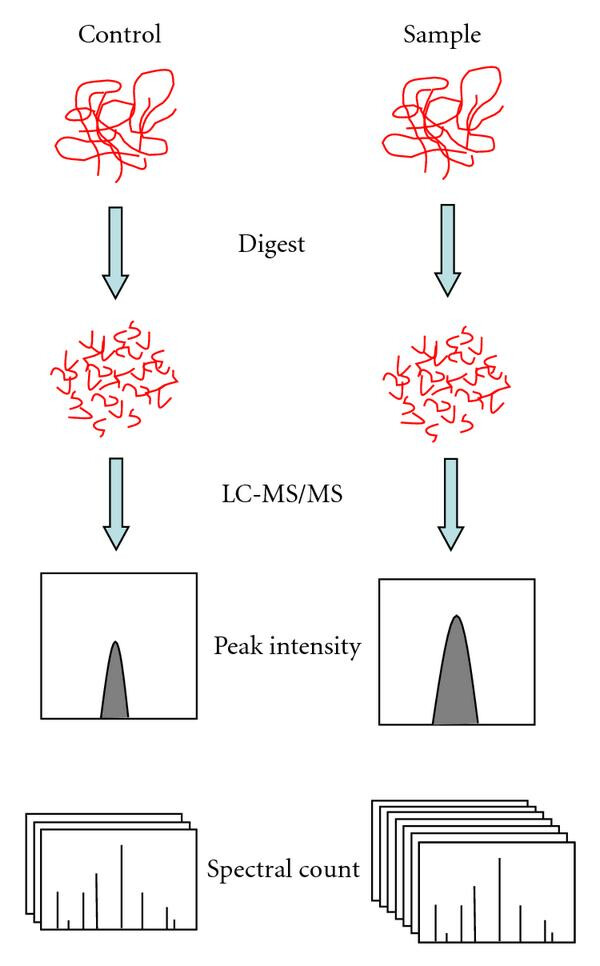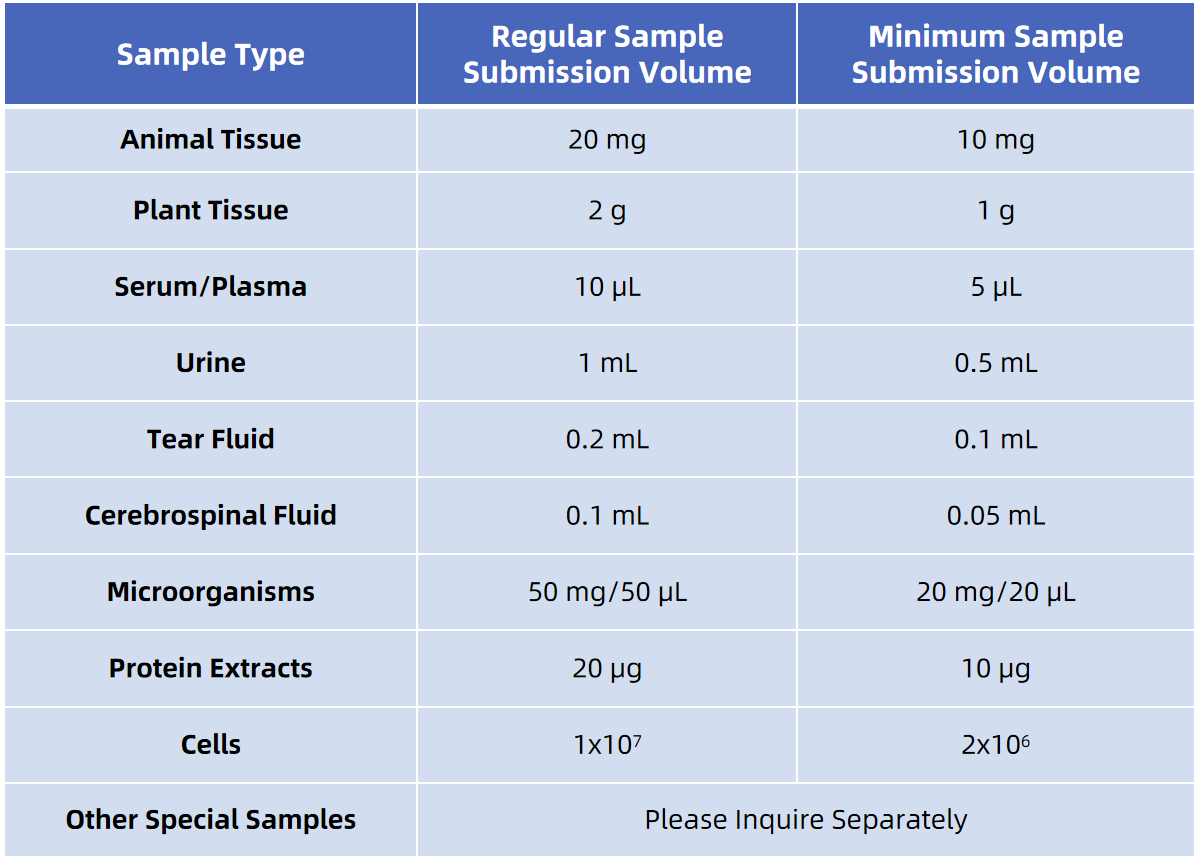Label Free Service
- Sample Preparation: Proteins are extracted from cells, tissues, or biological fluids, followed by concentration measurement and quality verification.
- Digestion: Proteins are digested into peptides using trypsin to ensure uniformity and detectability.
- Liquid Separation: Peptides are separated using high-performance liquid chromatography (HPLC), reducing sample complexity and enhancing detection.
- Mass Spectrometry Detection: High-resolution mass spectrometry (e.g., Orbitrap Fusion Lumos) is employed to detect peptides and acquire high-quality spectral data.
- Data Analysis: Protein identification and quantification are performed using specialized software such as Proteome Discoverer and MaxQuant.
- Eliminates chemical labeling, simplifying workflows and reducing costs.
- Offers high sensitivity, wide dynamic range, and low-abundance protein detection.
- Ensures consistent, reliable quantification without external labeling bias.
- Adapts to diverse sample types across multiple research fields.
- Disease Mechanism Research: Analyze protein expression changes in disease-associated pathways to reveal molecular mechanisms of development and progression.
- Drug Target Identification: Evaluate the effects of drug compounds on protein expression, accelerating the discovery of therapeutic targets.
- Biomarker Discovery: Identify potential diagnostic and prognostic biomarkers, driving advances in personalized medicine.
- Signal Pathway Analysis: Study protein functions within biological pathways, providing insights into complex biological processes.
- Environmental and Toxicology Research: Assess the effects of environmental factors or toxic agents on biological systems.
Label Free is an advanced mass spectrometry-based protein quantification method, enabling precise analysis of protein expression differences between samples without requiring chemical labeling. By comparing peptide signal intensity or detection frequency, it offers unparalleled flexibility and reliability. With its outstanding performance in quantification accuracy and data reproducibility, Label Free is suitable for diverse sample types, including cells, tissues, and biological fluids.
MtoZ Biolabs employs cutting-edge mass spectrometry platforms such as Thermo Fisher's Q Exactive HF, Orbitrap Fusion, and Orbitrap Fusion Lumos, integrated with Nano-LC systems, to provide professional Label Free service. Our solutions empower researchers in disease mechanism studies, drug development, and biomarker discovery by delivering high-quality data and robust technical support.
Technical Principles
Label Free relies on direct measurement of peptide abundance from mass spectrometry data, offering a flexible and effective alternative to labeling-based techniques. This approach provides highly accurate protein expression comparisons across samples, without the need for isotopic labels. The following are the key principles driving Label Free quantification:
1. Intensity-Based Quantification
This approach derives peptide abundance based on signal intensity or peak area in the mass spectrum. After normalization, it allows precise protein expression comparisons across samples. The method is well-suited for complex samples, providing a wide dynamic range, high sensitivity, and the ability to detect low-abundance proteins.
2. Spectral Counting
Protein abundance is estimated by counting the number of spectra detected for the target protein. A higher spectral count indicates greater abundance. This method is efficient and simple, making it ideal for large-scale proteomic studies and high-abundance protein quantification.
Analysis Workflow
The analysis workflow for Label Free service is designed to ensure accurate, high-quality protein identification and quantification. Each step is carefully executed to maximize sensitivity, reproducibility, and data integrity, providing comprehensive insights into the proteomic landscape of your samples.

Zhu, W. et al. J. Biomed. Biotechnol. 2010.
Service Advantages
Sample Submission Suggestions

Applications
Our Label Free service is applicable across a wide range of research areas, providing essential insights into protein expression and function. Below are some of the key applications where this approach can make a significant impact:
FAQ
Q1: What are the advantages and limitations of Label Free quantification compared to labeled quantification?
Label Free simplifies workflows and reduces costs by avoiding the need for isotope or chemical labeling. It is particularly suitable for processing large sample sets or those not amenable to labeling. With high throughput and wide coverage, Label Free is versatile across many research applications. However, slight variations in instrument performance or operating conditions during independent sample runs may affect results. To address this, we implement rigorous quality control and data normalization methods to ensure data accuracy and reliability.
Q2: Can Label Free detect post-translational modifications (PTMs) in proteins?
Yes, Label Free can quantify protein expression levels and detect PTMs such as phosphorylation and acetylation. By enriching modified peptides and integrating high-resolution mass spectrometry with advanced data analysis, we provide comprehensive insights into protein modification states and functional changes.
Deliverables
1. Comprehensive Experimental Details
2. Materials, Instruments, and Methods
3. Total Ion Chromatogram & Quality Control Assessment
4. Data Analysis, Preprocessing, and Estimation
5. Bioinformatics Analysis
6. Raw Data Files
MtoZ Biolabs, an integrated Chromatography and Mass Spectrometry (MS) Services Provider, provides advanced proteomics, metabolomics, and biopharmaceutical analysis services to researchers in biochemistry, biotechnology, and biopharmaceutical fields. Our ultimate aim is to provide more rapid, high-throughput, and cost-effective analysis, with exceptional data quality and minimal sample consumption. Free project evaluation, welcome to learn more details!
MtoZ Biolabs, an integrated chromatography and mass spectrometry (MS) services provider.
Related Services
Quantitative Proteomics Service
How to order?







